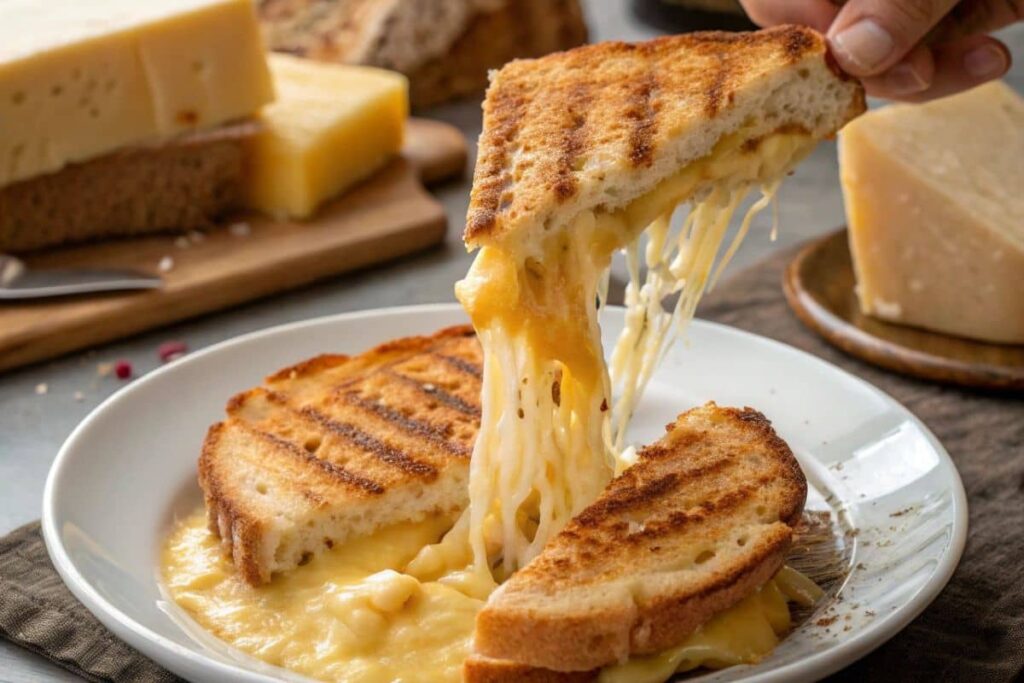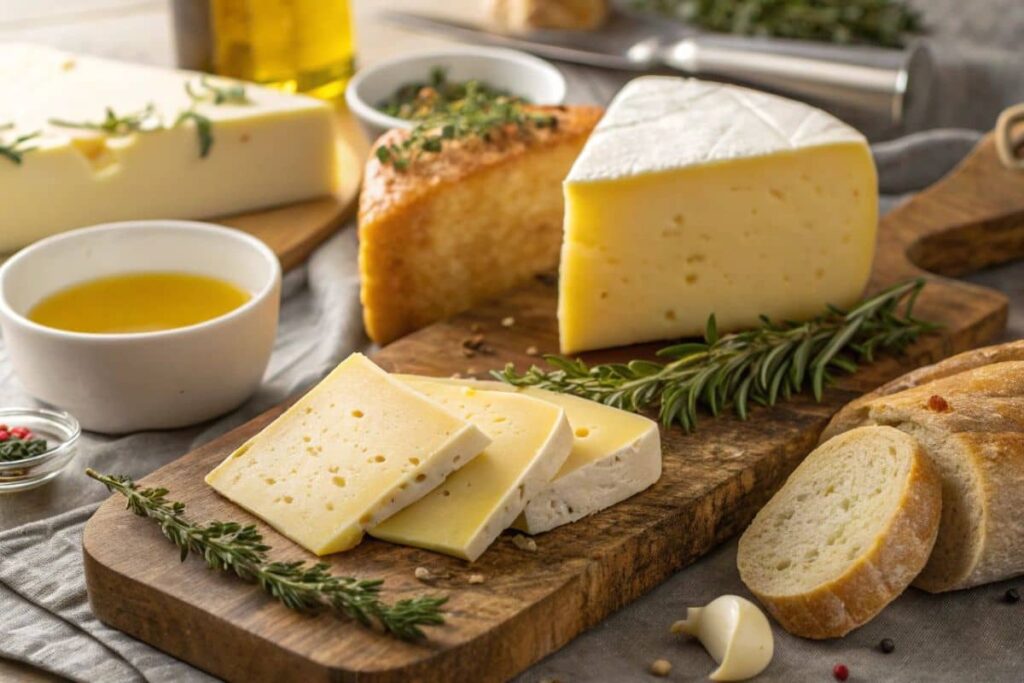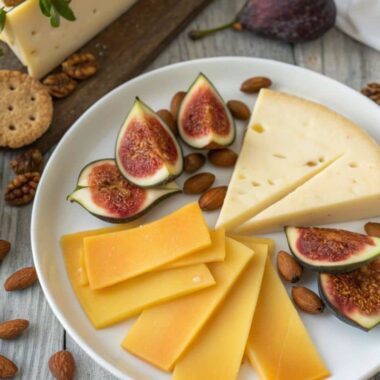When it comes to cheese, Gouda is a favorite for its rich flavor and versatility. But have you ever wondered, does Gouda cheese melt the way other cheeses do? Whether you’re dreaming of a gooey grilled cheese or a creamy pasta sauce, understanding how Gouda cheese melts can transform your cooking. This guide dives into everything you need to know about melting Gouda, so let’s get started on this cheesy journey!
Table of Contents

What Is Gouda Cheese?
The Origin and History of Gouda
Gouda cheese, pronounced “HOW-dah” (if you want to impress your foodie friends), hails from the Netherlands. It’s named after the Dutch city of Gouda, where it was historically traded. But Gouda isn’t just cheese; it’s a piece of history dating back to the 12th century! Imagine eating something that people enjoyed nearly 900 years ago. Cool, right?
How Gouda Cheese Is Made
Making Gouda is an art form. Milk, usually cow’s milk, is curdled, pressed, and aged to perfection. What makes it special is its aging process, which ranges from weeks to years. Younger Gouda is creamy and mild, while aged Gouda (also called “old Gouda”) develops a nutty, caramel-like flavor.
But here’s the big question: Does Gouda cheese melt? Absolutely! The melting quality depends on the type of Gouda. Young Gouda cheese melt easily into a smooth, creamy texture, making it perfect for sauces, grilled cheese, and mac and cheese. Aged varieties, on the other hand, are firmer and take longer to melt, but they deliver an intense, rich flavor when used in cooking.
So, if you’re looking for the best Gouda cheese melt, go for the younger versions. They soften quickly and create the ultimate gooey, cheesy experience. Whether you’re making a fondue, nachos, or a creamy pasta dish, choosing the right Gouda ensures the perfect Gouda cheese melt every time.
Would you prefer mild, melty cheese or an intense, nutty bite? Either way, Gouda cheese melt magic is real—just pick the right one for your dish!
Understanding the Melting Properties of Gouda Cheese
What Makes Cheese Melt?
Have you ever noticed that not all cheeses melt the same way? The melting ability of cheese depends on its moisture content, fat levels, and protein structure. High-moisture cheeses like mozzarella melt into stretchy, gooey perfection, while drier cheeses like Parmesan hardly melt at all.
Factors Affecting Gouda Cheese Melting
Gouda’s melting behavior depends on its age. Younger Gouda, with its higher moisture content, melts smoothly, creating a velvety texture. Aged Gouda, on the other hand, can be a bit stubborn—it softens but doesn’t become fully gooey. Why? Because aging reduces moisture and changes the protein structure, making it less pliable under heat.
Types of Gouda Cheese and Their Melting Behavior
Young vs. Aged Gouda: Which Melts Better?
Younger Gouda (aged 1-6 months) is the winner if you’re looking for a smooth, melty texture. It’s creamy, mild, and perfect for sauces or dips. Aged Gouda (aged over 1 year), however, adds depth of flavor to your dishes but may not achieve that ooey-gooey consistency.
Smoked Gouda: Does It Melt Like Regular Gouda?
Smoked Gouda is a game-changer. It has a smoky, earthy flavor that’s perfect for burgers and casseroles. It melts similarly to young Gouda, but its robust flavor can overpower delicate dishes. Use it when you want a smoky twist!
“Pro Tip: Pair smoked Gouda with caramelized onions for a heavenly flavor combo.”
How to Melt Gouda Cheese Perfectly
Melting Gouda isn’t rocket science, but a few tricks can make all the difference.
Tips for Melting Gouda on the Stovetop
- Shred the cheese: Smaller pieces melt faster and more evenly.
- Use low heat: Gouda can burn easily, so patience is key.
- Add a splash of milk or cream: This prevents clumping and ensures a silky texture.
Melting Gouda in the Oven
Want to top your casserole or pizza with melty Gouda? Grate it evenly over your dish and bake at 350°F (175°C) until it bubbles. A broiler can add that irresistible golden crust.
Can Gouda Be Melted in the Microwave?
Yes, but proceed with caution! Use a microwave-safe bowl, heat it in short intervals (10-15 seconds), and stir between each burst. Overheating can turn it into a rubbery mess.
Nutrition Facts of Gouda Cheese
| Nutrient | Amount (per 1 oz) |
|---|---|
| Calories | 101 kcal |
| Protein | 7.1 g |
| Fat | 7.8 g |
| Saturated Fat | 5.0 g |
| Carbohydrates | 0.6 g |
| Calcium | 200 mg |
| Sodium | 232 mg |
“While Gouda is rich in protein and calcium, its fat content means it’s best enjoyed in moderation. Balance is everything!”
Gouda Cheese in Recipes
Gouda cheese isn’t just delicious on its own—it’s a culinary superstar! Its unique flavor and melting properties make it a go-to for countless dishes. Let’s explore how to use Gouda to elevate your cooking game.
Best Dishes Using Melted Gouda Cheese
Gouda shines in so many recipes. Here are some fan-favorites:
- Gooey Grilled Cheese Sandwiches: Pair Gouda with sourdough bread and a touch of Dijon mustard for a grown-up twist.
- Creamy Mac and Cheese: Gouda adds a velvety, smoky note that’s impossible to resist.
- Gourmet Burgers: Melt Gouda over your burger patty for a rich, indulgent flavor.
- Cheesy Scalloped Potatoes: Thinly sliced potatoes layered with melted Gouda are a match made in heaven.
- Fondue Night: Melt Gouda with a splash of white wine for the ultimate dipping experience.
“Adding Gouda to your dishes is like upgrading from a standard phone to the latest smartphone—it’s a total game-changer!”
Creamy Gouda Mac and Cheese
This recipe takes classic mac and cheese to a gourmet level with the addition of creamy Gouda. Perfect for a cozy dinner or as a comforting side dish!
Ingredients
| Ingredient | Quantity |
|---|---|
| Elbow macaroni | 2 cups |
| Butter | 3 tablespoons |
| All-purpose flour | 3 tablespoons |
| Whole milk | 2 cups |
| Heavy cream | 1 cup |
| Gouda cheese (shredded) | 2 cups |
| Cheddar cheese (shredded) | 1 cup |
| Garlic powder | 1 teaspoon |
| Paprika | 1 teaspoon |
| Salt and pepper | To taste |
Instructions
- Cook the macaroni: Boil the pasta according to the package instructions until al dente. Drain and set aside.
- Make the roux: In a large saucepan, melt the butter over medium heat. Whisk in the flour and cook for 1-2 minutes until golden.
- Add the milk and cream: Gradually whisk in the milk and cream, stirring constantly until the mixture thickens.
- Melt the cheese: Lower the heat and stir in the shredded Gouda and cheddar until melted and smooth.
- Season the sauce: Add garlic powder, paprika, salt, and pepper. Adjust to taste.
- Combine with pasta: Mix the cooked macaroni into the cheese sauce, ensuring every piece is coated.
- Optional bake: Transfer to a baking dish, sprinkle with breadcrumbs, and bake at 375°F (190°C) for 10 minutes until golden.
Serve hot and enjoy the creamy, cheesy goodness!

Smoked Gouda Grilled Cheese Sandwich
This is not your ordinary grilled cheese—smoked Gouda takes it to the next level with its rich, smoky flavor.
Ingredients
| Ingredient | Quantity |
|---|---|
| Sourdough bread slices | 4 slices |
| Smoked Gouda cheese (sliced) | 4-6 slices |
| Butter (softened) | 2 tablespoons |
| Dijon mustard | 1 tablespoon |
| Optional: Caramelized onions | 1/4 cup |
Instructions
- Prepare the bread: Spread butter on one side of each bread slice. On the other side, spread a thin layer of Dijon mustard.
- Assemble the sandwich: Layer smoked Gouda slices on the mustard side of two bread slices. Add caramelized onions if desired. Top with the remaining bread, butter side out.
- Cook the sandwich: Heat a skillet over medium heat. Place the sandwiches in the skillet and cook until the bread is golden brown and the cheese is melted, about 3-4 minutes per side.
- Serve immediately: Slice diagonally and enjoy the smoky, gooey perfection.
Pro Tip: Pair with a bowl of tomato soup for the ultimate comfort meal!
Substituting Gouda in Recipes
Don’t have Gouda on hand? No worries! Substitute with cheeses like Havarti, Monterey Jack, or Edam. They share similar melting properties and flavors.
Common Problems When Melting Gouda Cheese
Even the best cooks can run into issues when melting Gouda. Let’s troubleshoot some common problems.
Why Doesn’t My Gouda Cheese Melt Properly?
If your Gouda isn’t melting the way you want, here are a few reasons why:
- It’s too aged: Older Gouda doesn’t melt as smoothly because of its reduced moisture content.
- Heat is too high: Overheating can cause Gouda to seize up and turn rubbery.
- Improper shredding: Large chunks take longer to melt and may not heat evenly.
How to Fix Clumpy or Stringy Gouda Cheese
If your melted Gouda turns into a clumpy mess, don’t panic! Here’s how to fix it:
- Add a liquid: Stir in milk, cream, or even beer to loosen up the texture.
- Use a whisk: This can help break up clumps and smooth the cheese out.
- Low and slow: Reduce the heat and let the Gouda melt gradually.
Gouda Cheese Alternatives for Melting

If Gouda isn’t your first choice, there are plenty of alternatives that melt beautifully.
Other Cheeses with Similar Melting Properties
- Havarti: Creamy and mild, it melts just as easily as young Gouda.
- Monterey Jack: A great option for Tex-Mex dishes, it’s gooey and mild.
- Fontina: Perfect for sauces and fondues, with a slightly nutty flavor.
Combining Gouda with Other Cheeses for Perfect Melts
Why stop at Gouda? Blend it with other cheeses for a flavor-packed experience. Try mixing Gouda with:
- Mozzarella: For stretchiness.
- Parmesan: For a sharp, salty kick.
- Cheddar: For that classic cheesy taste.
“Cheese blends are like a symphony—they create a harmony of flavors that’s music to your taste buds!”
Gouda Cheese: Nutritional Benefits and Uses
We all know Gouda is delicious, but did you know it’s also packed with nutrients?
Is Gouda Cheese Healthy?
Gouda provides essential nutrients like calcium, protein, and vitamin D. However, it’s high in fat and sodium, so moderation is key. Think of Gouda as a treat, not a staple.
How to Store Gouda Cheese Properly
To keep Gouda fresh and flavorful, follow these tips:
- Wrap it well: Use wax paper or parchment paper, then seal it in an airtight container.
- Refrigerate it: Store Gouda in the cheese drawer or the coldest part of your fridge.
- Freeze with caution: While you can freeze Gouda, it may lose some texture and flavor.
Frequently Asked Questions About Gouda Cheese
1. Can I freeze Gouda cheese before melting it?
Yes, you can freeze Gouda cheese, but there are a few things to keep in mind. Freezing changes the texture of cheese, making it more crumbly and less ideal for slicing or eating fresh. However, frozen Gouda works well in recipes where melting is involved, like soups, sauces, or casseroles.
- How to freeze it properly: Wrap the cheese tightly in plastic wrap, then place it in an airtight freezer bag or container. Label it with the date and use it within 6 months.
- Thawing tip: Thaw Gouda in the refrigerator overnight to retain as much of its original texture as possible.
2. What’s the best way to shred Gouda cheese for melting?
Shredding Gouda ensures even melting, especially in dishes like mac and cheese or pizza. Here’s how to do it right:
- Chill the cheese first: Pop the Gouda in the freezer for about 10 minutes. This firms it up and makes shredding easier.
- Use the right tool: A box grater works best for semi-soft Gouda. For larger quantities, use a food processor with a shredding attachment.
- Remove the wax rind: If your Gouda has a wax coating, carefully slice it off before shredding.
3. Why doesn’t my Gouda cheese melt properly?
If your Gouda isn’t melting as expected, these could be the reasons:
- The cheese is too aged: Aged Gouda has lower moisture content, which makes it less pliable under heat. It softens but doesn’t get gooey.
- Heat is too high: Melting Gouda requires gentle, low heat. High heat can cause the cheese to seize and become rubbery.
- Lack of added moisture: When melting Gouda for sauces or dips, adding a splash of milk, cream, or even beer can help achieve a smoother consistency.
4. Can I use Gouda for fondue?
Absolutely! Gouda, especially young or smoked varieties, is an excellent choice for fondue. Its creamy texture and rich flavor create a luxurious dipping sauce.
- Pro tip: Mix Gouda with other melting cheeses like Gruyère or Fontina for a balanced flavor. Add a splash of white wine or broth to keep the fondue smooth and prevent clumping.
5. How does smoked Gouda compare to regular Gouda for melting?
Smoked Gouda melts similarly to young regular Gouda but with a smoky twist. Its robust flavor works best in recipes that can handle bold tastes, like burgers, grilled cheese, or pasta bakes.
- Pairing tip: Smoked Gouda pairs wonderfully with ingredients like bacon, caramelized onions, or roasted vegetables.
6. Is Gouda cheese suitable for lactose-intolerant people?
The good news is that aged Gouda is naturally low in lactose, making it more tolerable for some people with lactose sensitivity. However, younger Gouda has slightly higher lactose content. If you’re highly sensitive, opt for cheeses labeled as lactose-free.
7. Can I combine Gouda with other cheeses for better melting?
Yes, blending Gouda with other cheeses can create a perfect balance of flavor and texture. Some great combinations include:
- Mozzarella: Adds a stretchy, gooey quality to the melt.
- Parmesan: Offers a sharp, salty kick.
- Cheddar: Enhances the cheesiness while complementing Gouda’s creamy flavor.
8. What dishes are best for melted Gouda?
Melted Gouda works in a variety of dishes, including:
- Sandwiches: Grilled cheese or paninis.
- Casseroles: Cheesy potatoes, baked pastas.
- Soups: Creamy cheese-based soups.
- Dips: Fondue or cheese sauces for veggies and nachos.
9. Is there a difference between Dutch Gouda and American Gouda?
Yes, there are subtle differences. Dutch Gouda tends to follow traditional aging and production methods, giving it a richer and more nuanced flavor. American Gouda, while still delicious, may have a milder taste and softer texture, as it’s often made for immediate consumption.
10. Can Gouda cheese be microwaved for melting?
Yes, but microwaving Gouda requires caution. Here’s how to do it without ruining your cheese:
- Use short intervals: Heat the cheese in 10-15 second bursts, stirring in between.
- Add moisture: A splash of milk or cream can prevent the cheese from drying out.
- Avoid overheating: Overheating Gouda can turn it rubbery, so keep a close eye on it.
Pro Tip: Always shred or cube Gouda before microwaving to ensure even heating.
Conclusion: Does Gouda Cheese Melt?
In conclusion, yes, Gouda cheese does melt, but its melting behavior depends on its age and preparation. Young Gouda is perfect for achieving that creamy, gooey consistency in dishes like mac and cheese, while aged Gouda adds a bold, nutty flavor that’s ideal for gourmet creations. If you’re looking for the ultimate Gouda cheese melt, opt for a younger variety and use gentle heat to get that smooth, velvety texture. With the tips and tricks shared in this guide, you’ll master the art of melting Gouda and take your recipes to the next level.
Looking for more cheesy insights? Don’t miss these related articles:
- Is Gouda Cheese Healthy? to learn about its nutritional benefits.
- Is Gouda Cheese Good for Grilled Cheese? to discover why it’s a favorite for sandwiches.
- Gouda Cheese for a comprehensive overview of this Dutch delight.
- Is Blue Cheese Good for Your Gut? to explore the health perks of other cheeses.
- Can I Freeze Blue Cheese? for tips that also apply to Gouda storage.
- Cottage Cheese Recipes for lighter, versatile cheesy dishes.
Whether you’re crafting a grilled cheese masterpiece or experimenting with gourmet casseroles, Gouda is a cheese that never disappoints. Embrace its versatility and let it transform your meals into something extraordinary. Happy cooking!

Gouda Cheese Melting Guide
Ingredients
For the Creamy Gouda Mac and Cheese
- 2 cups Elbow macaroni Cook according to package instructions.
- 3 tablespoons Butter For making the roux.
- 3 tablespoons All-purpose flour For thickening the cheese sauce.
- 2 cups Whole milk For a creamy texture.
- 1 cup Heavy cream For richness.
- 2 cups Gouda cheese (shredded) Use young Gouda for best melting.
- 1 cup Cheddar cheese (shredded) For added flavor.
- 1 teaspoon Garlic powder For seasoning.
- 1 teaspoon Paprika For a slight smoky flavor.
- Salt and pepper To taste.
For the Smoked Gouda Grilled Cheese Sandwich
- 4 slices Sourdough bread For the base of the sandwich.
- 4-6 slices Smoked Gouda cheese Thinly sliced.
- 2 tablespoons Butter (softened) For spreading on bread.
- 1 tablespoon Dijon mustard For extra flavor.
- 1/4 cup Caramelized onions (optional) For added sweetness.
Instructions
Creamy Gouda Mac and Cheese Preparation
- Cook the macaroni according to the package instructions until al dente. Drain and set aside.
- In a large saucepan, melt the butter over medium heat. Whisk in the flour and cook for 1-2 minutes until golden.
- Gradually whisk in the milk and cream, stirring constantly until the mixture thickens.
- Lower the heat and stir in the shredded Gouda and cheddar until melted and smooth.
- Add garlic powder, paprika, salt, and pepper. Adjust to taste.
- Mix the cooked macaroni into the cheese sauce, ensuring that every piece is coated.
- Transfer to a baking dish, sprinkle with breadcrumbs, and bake at 375°F (190°C) for 10 minutes until golden.
Smoked Gouda Grilled Cheese Preparation
- Spread butter on one side of each slice of bread. On the other side, spread a thin layer of Dijon mustard.
- Layer smoked Gouda slices on the mustard side of two bread slices. Add caramelized onions if desired. Top with the remaining bread, butter side out.
- Heat a skillet over medium heat. Place the sandwiches in the skillet and cook until the bread is golden brown and the cheese is melted, about 3-4 minutes per side.
- Slice diagonally and serve immediately.





